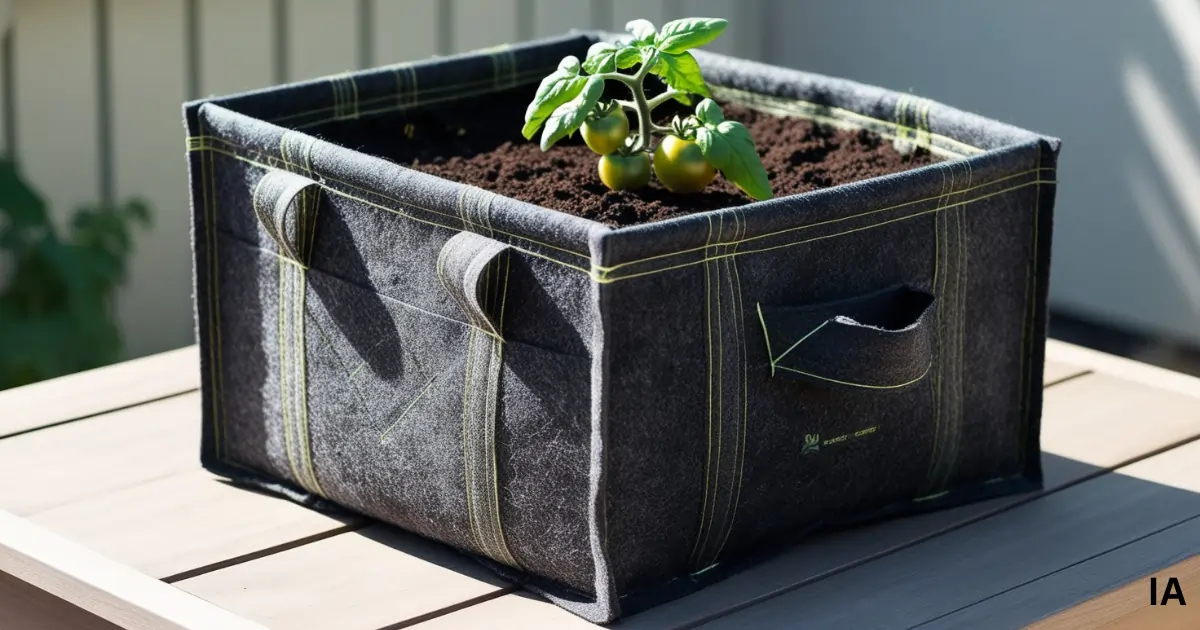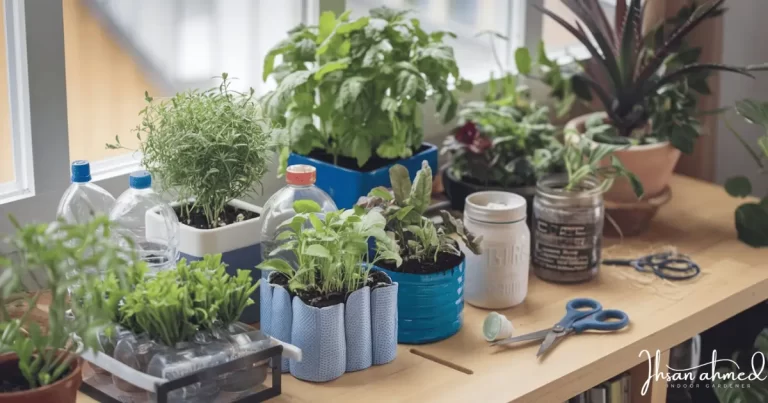1. What are Fabric Grow Bags?

Grow bags are breathable in nature and also called fabric containers or pots which promote their roots for air and moisture circulation.
It can control the temperature, is portable and lightweight, perfect for indoor for any type of plant.
Essential uses of grow bags indoors
Grow bags help root health, prevents water buildup, improve air circulation, portable and more flexible.
- Helps air reach its roots to prevent it from overheating.
- Fabric grow bag promote their roots from “air pruning”
- Prevent root rot and better drainage
- Lightweight and portable to move from one place to another.
- Available in various different sizes
How do grow bags benefit from other materials?
Grow bags are superior in drainage and air circulation control when compared to plastic and ceramic pots.
They are also lightweight, easy to move, and environmentally friendly but they lack water drainage and air circulation compared to fabric pots.
Fabric bags prevent root rot and overheating and promote eco-friendly and Sustainable gardening.
2. Key benefits of grow bags

Grow bags are lightweight, breathable containers designed to promote healthy root growth and prevent common gardening issues. They offer a sustainable and flexible solution for indoor plants.
Enhanced Breathability for Root Health
Grow bags help the air circulate and protect their roots from being bound and suffocated. This helps to improve nutrient absorption, rapid growth, and healthy plants.
Lightweight and Portable
These bags are less weight and easy to move from one place to another to adjust based on sunlight and can help to rearrange indoor gardening setups.
These grow bags are perfect for beginners as well as those who wish to rearrange the plants periodically to keep away from messy indoor gardening.
Prevents Water Buildup and Root Rot
Fabric grow bag has a perfect drainage system that helps water leakage at the bottom and protects from root rot, these plants help to keep the soil moisture longer.
Available in Many Sizes for Different Plant Types
Grow bags have different sizes based on plant needs from small herbs to large vegetables, it helps the gardeners to choose based on their needs.
Eco-Friendly and Sustainable Options
Grow bags are made of recyclable materials, eco-friendly and alternative to traditional containers, durable and reusable for multiple growing seasons based on plant needs.
3. Best Indoor Plants for Fabric Grow Bags

Grow bags are the perfect choice for many indoor plants, here we listed a few of them that are commonly used by indoor gardeners.
Herbs (Basil, Parsley, Mint)
Small grow bags are a perfect choice for herbs (1-2 Gallons) come in excellent drainage and air circulation, are portable allow easy handling to shift the places from one place to another based on sun direction.
Tomatoes
There is a myth about tomatoes, that can’t grow in grow bags but it’s not true, Tomatoes can grow well (New and small plants) in larger fabric bags (5 gallons), and at least (10 Gallons) for larger plants to spread their roots and make their roots strong prevent from root rot, perfect for indoor environment.
Tomatoes need plenty of sunlight (6- 8 Hours) direct sunlight or (12- 16 Hours) Grow lights.
Peppers (Bell and Chili Peppers)
Peppers are grown in deep roots (3-5 Gallons) for small varieties like chili and above (5 Gallons) for larger varieties like Bell Peppers keep the plants at least 6-8 hours of direct sunlight essential as tomatoes.
Lettuce and Leafy Greens
Leafy greens like lettuce and spinach can be grown in small grow bags of (2-3 gallons), these plants don’t need deep roots and can be grown in small bags, and larger Leafy Greens like kale need (3-5 gallons) to spread their roots.
Both these plants need at least 4-6 hours of direct sunlight is mandatory, these grow bags help to handle easily to move around sunlight directions.
Cucumbers
Cucumbers need larger spaces to grow at least 7 Gallons to survive for deeper roots, these grow bags help from waterlogging and are ideal for indoor gardening with at least 6-8 hours of direct sunlight like tomatoes and peppers.
4. Setting Up and Caring for Indoor Grow Bags

Grow bags are convenient and flexible options for indoor gardening. Follow these essential steps to maintain the grow bags.
Choose the Right Size Bag
You need to pick the right size for your plants, you need at least (1-2 gallons of small bags for herbs and (5+ gallons) larger bags for vegetables, it helps for enough room to spread their roots for healthy growth.
Use a Well-Draining Soil Mix
Recommended to use well drainage potting soil if required, add perlite or coco air for improved soil aeration. These items help to prevent root rot in grow bags.
Ensure Proper Sunlight
Place the grow bags near the sunny window or use grow light, if the sunlight is not sufficient. Most herbs and vegetables need at least 6-8 hours of direct sunlight for healthy growth.
Monitor Watering
Grow bags dry out the soil faster and keep an eye on soil moisture. If the top layer of the soil is dry, add water and be cautious with overwatering.
Fertilize Regularly
You need to feed at least 2-4 weeks of balanced and liquid fertilizer, you need regular nutrients to thrive the plants, as grow bags drain quickly.
5. Growing tomatoes in grow bags

Producing fresh and juicy tomatoes in grow bags is a great option for indoor gardening, even in small and limited spaces.
Essential Items
- 10-15 gallon fabric grow bag
- High-quality potting mix
- Organic compost or worm castings
- Perlite or vermiculite (for drainage)
- Tomato seedlings
- Stake or tomato cage for support
- Fertilizer (organic or balanced)
Here’s a step-by-step guide to growing healthy tomatoes in fabric grow bags
- Fill the grow bag with potting mix.
- Add compost, and perlite for drainage.
- Plant the tomato seedling deeper to cover the first set of leaves.
- Place the grow bag in a windowsill for 6-8 hours of direct sunlight.
- Use a stake or tomato cage to support when the plants start growing taller.
- Fertilize every 2-4 weeks and prune extra suckers.
- Need to monitor the plants to be free from pests and provide adequate air circulation.
- When tomatoes are ready to ripe, harvest and enjoy the fresh and juicy tomatoes.
6. Common Mistakes to Avoid in Fabric Grow Bag

Grow bags are effective and convenient, but need to avoid some common mistakes that eliminate plant growth.
A few of them are listed below
Overwatering
Grow bags dry out faster than any other traditional pots, overwatering can be a big issue that leads to root rot and damage the plant growth.
Always check the soil before you water, make a finger two inches deep if it is dry, it’s time for watering, and if it is wet wait for some time check again, and feed them.
Don’t hesitate to try this before watering, please don’t kill the plants, they also have life.
Using the Wrong Soil
Don’t use garden soil or poor-quality soil mix, it can suffocate their roots in grow bags. Use light and high-quality soil mixes with perlite and vermiculite for improved soil aeration.
Not Providing Enough Light
If your plants lack on sufficient amount of light, then your plants become weak and leggy.
At least 6-8 hours of direct sunlight or full spectrum LED Grow lights are mandatory if your home is in shortage of natural sunlight.
Skipping Fertilization
Fabric-grown bags dry out water quickly same way nutrients also dry out, if you don’t fertilize them every 2-4 weeks then your plants may suffer from nutrient deficiencies, leading to pale leaves, yellow leaves, and stunted growth.
Ignoring Plant Support
Plants like tomatoes and peppers require proper supporting cages to grow taller and can break the stems, hard for plants to grow without support, especially in the early stages.
Overcrowding Bags
Don’t overcrowd the plants in one bag, it eliminates air circulation and nutrients for each plant.
It may lead to pest diseases and stunted growth, strictly one plant’s pet grow bags, which give more energy, more control, and more airflow that flourish your garden.
Conclusion
In summary, fabric grow bags are an excellent choice to grow herbs and vegetables indoors and are eco-friendly promoting healthy roots and maximizing the space.
Ideal for small space gardening with the right care you can produce herbs and vegetables throughout the year without worrying about a season.
For more indoor container gardening ideas, explore a few of our other topics on how to choose indoor container materials and 15 easy indoor gardening ideas.
And also read further on essential gardening supplies for indoor gardening and tools storage hacks.
What makes fabric grow bags ideal for indoor gardening?
Fabric grow bag are breathable and help regulate air circulation around the roots, reducing the chance of root rot. They’re lightweight, portable, and perfect for a variety of indoor plants like tomatoes, herbs, and leafy greens, allowing for year-round gardening regardless of season.
How are fabric grow bag different from traditional pots?
Fabric grow bag offer superior drainage and airflow compared to traditional ceramic or plastic pots. This setup prevents water buildup and root rot, common in non-breathable containers. Fabric bags also encourage “air pruning,” which promotes healthier root development.
What are some common mistakes to avoid when using fabric grow bag?
Key mistakes include overwatering, using poor-quality soil, skipping fertilizer, providing insufficient light, and overcrowding plants in a single bag. Monitoring these areas ensures plants receive proper care for healthy growth in fabric bags.
How should I care for plants in fabric grow bag?
Choose the right size bag, use a well-draining soil mix, monitor watering closely, and ensure plants receive 6-8 hours of sunlight. Fertilize every 2-4 weeks and use plant supports like cages for taller plants like tomatoes and peppers.
Can I grow tomatoes in fabric grow bag indoors?
Yes, tomatoes grow well in fabric bags, ideally in sizes of 10-15 gallons for strong root support. Position bags for 6-8 hours of sunlight or use grow lights if natural light is limited. Regular fertilizing and using a tomato cage for support will encourage a healthy harvest.






